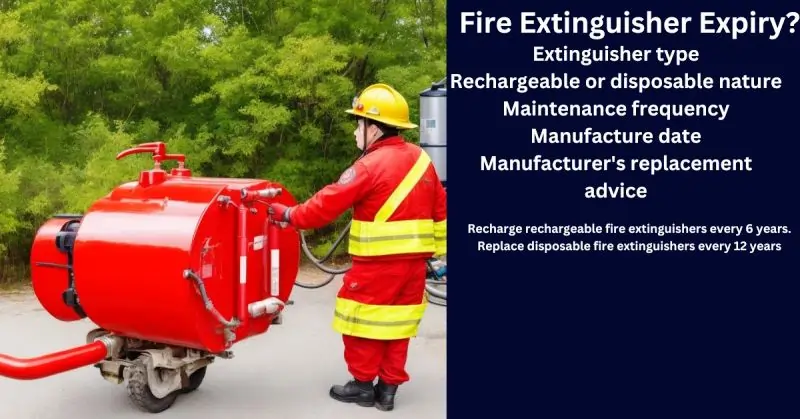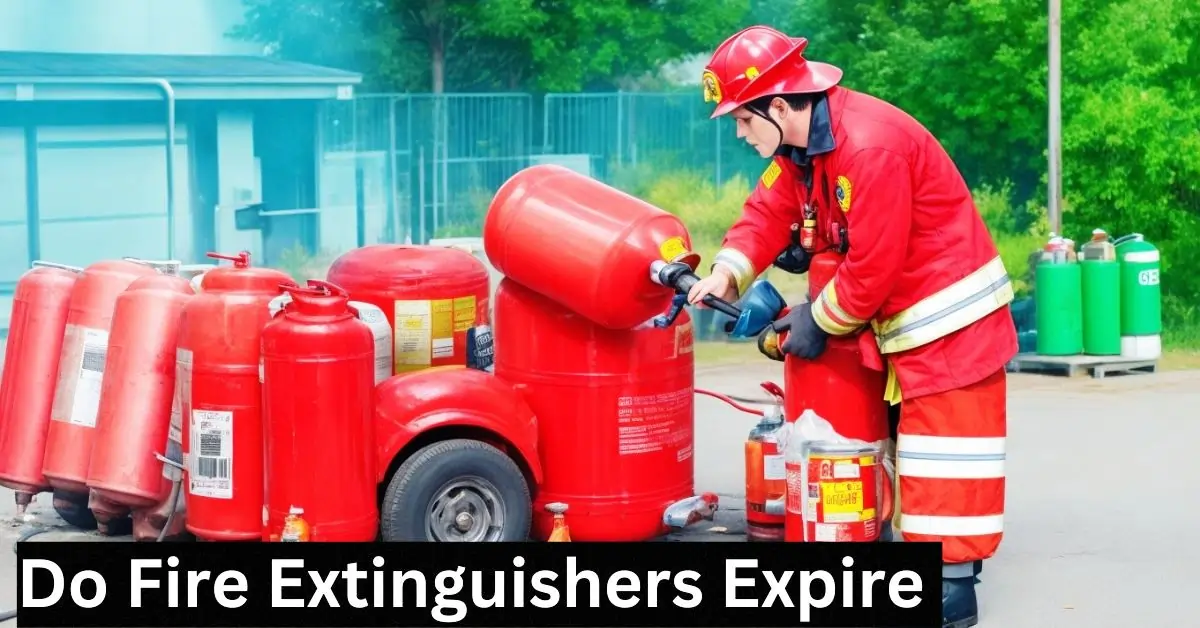Do Fire Extinguishers Expire
Fire extinguishers play a crucial role in safeguarding homes, workplaces, and ships from unexpected fires. Whether it’s a small kitchen fire or a potential hazard in a marine engine room, having a functional fire extinguisher on hand can make the difference between a minor incident and a major disaster. However, many people wonder, do fire extinguishers expire? This is an important question, as relying on an expired extinguisher could lead to failure when you need it most. Keeping your extinguisher in good condition is essential for safety, and understanding its expiration is key. In this post, we’ll explore five essential facts to help clear up any confusion and ensure you’re prepared for any emergency.
Yes, Fire Extinguishers Can Expire

Fire extinguishers typically have a lifespan of 5 to 15 years, depending on the type. The exact expiration can vary based on the materials and chemicals inside the extinguisher. For example, ABC dry chemical often last around 12 years, while CO2 and water-based extinguishers may have slightly shorter or longer lifespans depending on usage and storage conditions.
To determine whether your fire extinguisher is still effective, always check the label for the manufacture date. Some extinguishers include a specific expiration date, while others may only show the production date. As a general rule, replace or service the extinguisher if it’s nearing the 10-year mark. Additionally, if you notice any damage, corrosion, or loss of pressure (shown by the gauge reading in the red zone), it’s time to consider replacing it, regardless of the official expiration timeline.
Signs Your Fire Extinguisher Needs Replacement
Fire extinguishers are essential safety tools, but like any equipment, they can wear out over time. Here are the key signs that indicate your fire extinguisher needs to be replaced:
1. Pressure Gauge in the Red Zone
- The pressure gauge is one of the first indicators of a fire extinguisher’s condition. If the needle is in the red zone, either too low or too high, it means the extinguisher isn’t pressurized properly. Low pressure means it may not discharge correctly during an emergency, while over-pressurization can pose a risk of the unit exploding. Recharging might not resolve the issue if it’s consistently in the red zone—replacement may be required.
2. Visible Damage or Corrosion
- Any signs of external damage, such as dents, cracks, or corrosion, can compromise the structural integrity of the fire extinguisher. Rust and corrosion can weaken the container, increasing the risk of leaks or even rupture under pressure. Dents may indicate that the internal components have been damaged, reducing effectiveness. If there are noticeable signs of wear and tear, the extinguisher should be replaced immediately to avoid failure.
3. Missing or Broken Seal and Pin
- The safety pin and tamper seal are critical components that ensure the extinguisher is ready for use in emergencies. If the pin is missing or broken, or if the tamper seal is compromised, it may indicate that the extinguisher has been used or tampered with. In such cases, even if the extinguisher hasn’t been discharged, it’s unsafe to rely on. A missing pin or broken seal requires professional inspection, and often, replacement is the best solution.
4. Obsolete or Recalled Model
- Fire extinguisher technology evolves, and older models may no longer meet current safety standards. Additionally, some extinguishers are subject to manufacturer recalls due to design flaws or other issues. If your extinguisher is outdated or recalled, it’s essential to replace it with a modern, compliant model. Check with the manufacturer or a fire safety professional if you’re unsure about your extinguisher’s status.
5. Leaking Extinguisher
- If you notice any leakage around the nozzle, hose, or cylinder, the fire extinguisher is no longer reliable. Leaks can reduce the pressure inside the extinguisher, rendering it ineffective in an emergency. Leaks can also indicate internal damage that can’t be fixed through recharging, requiring a full replacement.
6. Expired Extinguisher
- Every fire extinguisher has a lifespan, typically between 5 to 15 years, depending on the model and type. Check the label for the manufacture or expiration date. If the extinguisher is past its expiry, it should be replaced, even if it appears to be in good condition. Expired extinguishers are more likely to malfunction or fail during use, making them a liability in critical situations.
7. Failed Inspection or Testing
- Fire extinguishers undergo routine inspections and maintenance checks to ensure they remain operational. If your extinguisher fails a professional inspection or hydrostatic test (which checks the cylinder’s ability to contain pressure), it’s a sign that it needs replacement. These tests are crucial for identifying hidden damage that may not be visible through casual observation.
How to Properly Maintain Your Fire Extinguisher
Proper maintenance of your fire extinguisher is essential for ensuring it functions correctly in an emergency. Follow these steps to maintain your fire extinguisher:
1. Monthly Visual Inspections
- Check the Pressure Gauge: Ensure the pressure gauge needle is in the green zone, indicating the extinguisher is fully pressurized and ready for use.
- Inspect for Visible Damage: Look for any dents, rust, corrosion, or cracks in the body. Damage can compromise the extinguisher’s ability to function.
- Check the Seal and Pin: The safety pin and tamper seal should be intact. A missing or broken seal could indicate tampering, making the extinguisher unreliable.
- Nozzle Condition: Ensure the nozzle is free of obstructions, dirt, or debris that could block the flow of the extinguishing agent.
2. Yearly Professional Servicing
- Schedule an Annual Inspection: Fire extinguishers should be inspected by a certified professional once a year. They will check the internal components, pressure, and extinguishing agent to ensure everything is in working order.
- Hydrostatic Testing: If your extinguisher is older or has been in rough environments, professionals may perform hydrostatic testing to check the strength of the container.
- Recharging: After any use or when the pressure is low, professionals can recharge rechargeable fire extinguishers with new extinguishing agents and ensure proper pressure.
3. Proper Storage
- Location: Store your extinguisher in an easily accessible location, such as near exits or high-risk areas like kitchens or workshops. It should be in plain sight and free from obstructions.
- Environment: Fire extinguishers should be stored in a cool, dry location, away from direct sunlight or chemicals that could cause corrosion. Avoid placing them in areas with extreme temperatures, as this can affect performance.
4. Ensure Easy Access
- Mount the Extinguisher: Use an appropriate wall mount or holder to keep the extinguisher in place. It should be within easy reach, but out of the way enough to avoid accidental damage.
- Familiarize Users: Everyone in your household, workplace, or crew should know the extinguisher’s location and understand how to operate it in an emergency. Training sessions or safety briefings can help with this.
5. Replace or Recharge After Use
- Even after partial use, fire extinguishers must be recharged immediately to ensure they are fully ready for the next emergency. Disposable extinguishers should be replaced after use.
When to Recharge Fire Extinguishers
Knowing when to recharge a fire extinguisher is crucial to ensuring it’s always ready to use in an emergency. Here’s a detailed guide on when recharging is necessary:
- After Partial Use: Even if your fire extinguisher has only been partially discharged, it needs to be recharged immediately. Any use can deplete the pressure and extinguishing agent, leaving the extinguisher ineffective for future incidents.
- Pressure Gauge in the Red Zone: Fire extinguishers have a pressure gauge that indicates whether they are ready for use. If the needle falls into the red zone, even without use, the extinguisher must be recharged. Low pressure compromises its ability to work properly.
- Regular Maintenance: During annual inspections, fire safety professionals may recommend recharging even if the extinguisher hasn’t been used. This ensures that the unit is fully pressurized and the extinguishing agent is at optimal levels.
- Visible Damage or Corrosion: If your extinguisher shows signs of wear, such as rust or corrosion, it may be losing pressure even if unused. In such cases, have it inspected and recharged or replaced, depending on the severity of the damage.
Note: Only rechargeable fire extinguishers (typically those with metal valves) can be serviced. Disposable extinguishers, which often feature plastic valves, must be replaced after use.
Recharging should always be done by a professional service to ensure the extinguisher is properly refilled and pressurized, guaranteeing its reliability in future emergencies.
How to Dispose of Expired Fire Extinguishers
Disposing of expired fire extinguishers requires careful handling to ensure safety and environmental responsibility. Here’s how to do it properly:
- Check the extinguisher: Before disposal, confirm that the extinguisher is no longer functional. If it’s empty, squeeze the handle to release any remaining pressure, ensuring that it’s fully discharged.
- Contact local fire departments: Many fire departments offer disposal services or can direct you to the appropriate facility for safe disposal.
- Use hazardous waste disposal centers: These centers are equipped to handle fire extinguishers, especially those containing chemicals. It’s an eco-friendly way to dispose of them without harming the environment.
- Recycling programs: Some communities have recycling programs for metal extinguishers. If your extinguisher is made of recyclable materials, ensure it is properly discharged before recycling.
Avoid keeping expired extinguishers, as they can leak chemicals or fail when needed, posing significant risks.
Conclusion
In this post, we covered the essential facts about fire extinguisher expiration, from understanding their lifespan to recognizing signs for replacement and the importance of regular maintenance. We also discussed when recharging is an option and how to properly dispose of expired units. Fire extinguishers are crucial safety tools, and keeping them in good working order ensures they’re ready to protect you when it matters most.
Now is the perfect time to check your fire extinguishers at home, work, or on board your vessel. Regular inspections and timely replacements are key to ensuring safety in case of a fire emergency. If your extinguisher is nearing expiration or shows signs of damage, schedule a professional inspection or consider replacing it today. Don’t wait until it’s too late—take action now to ensure you’re always prepared for an emergency.
FAQ on “Do Fire Extinguishers Expire
Q: Do fire extinguishers have a set expiration date?
A: No, they don’t have a specific expiration date but need maintenance and eventual replacement.
Q: How can I tell if my fire extinguisher is ineffective?
A: Check the pressure gauge; it may need servicing or replacement if it’s not in the green zone
Q: Is it safe to use an old fire extinguisher?
A: It’s best to get it checked; an outdated or unmaintained extinguisher might not work when needed
Q: How often should I inspect my fire extinguisher?
A: Monthly visual checks are good, but a professional inspection should happen annually.
